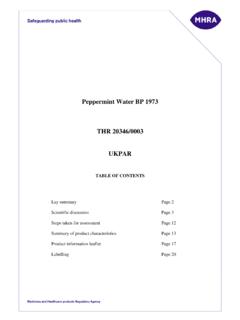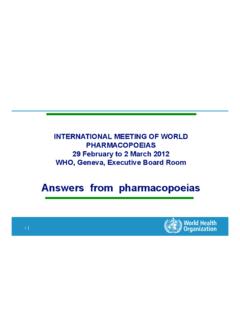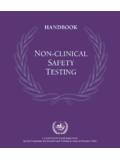Transcription of European Medicines Agency
1 European Medicines Agency 7 Westferry Circus, Canary Wharf, London, E14 4HB, UK Tel. (44-20) 74 18 85 75 Fax (44-20) 75 23 70 40 E-mail: European Medicines Agency , 2008. Reproduction is authorised provided the source is acknowledged June 2008 EMEA/CHMP/ICH/308895/2008 ICH Topic Q4B Annex 5 Disintegration Test General Chapter Step 3 ANNEX 5 TO NOTE FOR EVALUATION AND RECOMMENDATION OF PHARMACOPOEIAL TEXTS FOR USE IN THE ICH REGIONS ON DISINTEGRATION TEST GENERAL CHAPTER (EMEA/CHMP/ICH/308895/2008) TRANSMISSION TO CHMP June 2008 TRANSMISSION TO INTERESTED PARTIES June 2008 DEADLINE FOR COMMENTS September 2008 Please forward your comments to the following email address: TABLE OF CONTENTS 1.
2 2. Q4B ANALYTICAL ACCEPTANCE 3. TIMING OF ANNEX 4. CONSIDERATIONS FOR 5. REFERENCES USED FOR THE Q4B DRAFT SUPPLEMENT II TO THE EMEA 2008 Page 2/7 1. Introduction This annex is the result of the Q4B process for Disintegration Test General Chapter. The proposed texts were submitted by the Pharmacopoeial Discussion Group (PDG). 2. Q4B Outcome Analytical Procedures The ICH Steering Committee, based on the evaluation by the Q4B Expert Working Group (EWG), recommends that for tablets and capsules, the official pharmacopoeial texts, Disintegration of Tablets and Capsules, JP Disintegration Test, and USP <701> Disintegration can be used as interchangeable in the ICH regions subject to the conditions detailed below. Testing conditions for specific dosage forms are outside the scope of the harmonization of this chapter.
3 The Disintegration Test is not considered to be interchangeable in the three regions for tablets and capsules larger than 18 millimeters (mm) long. The Disintegration Test is not considered to be interchangeable in the three regions for enteric coated preparations. Product-specific parameters such as media and the use of discs should be specified in the application dossier. Acceptance Criteria Acceptance criteria are outside the scope of the harmonization of this chapter and should be specified in the application dossier. 3. Timing of Annex Implementation When this annex is implemented (incorporated into the regulatory process at ICH Step 5) in a region, it can be used in that region. Timing might differ for each region. 4. Considerations for Implementation General consideration: When sponsors or manufacturers change their existing methods to the implemented Q4B-evaluated pharmacopoeial texts that are referenced in Section of this annex, any change notification, variation, and/or prior approval procedures should be handled in accordance with established regional regulatory mechanisms pertaining to compendial changes.
4 FDA consideration: Based on the recommendation above, and with reference to the conditions set forth in this annex, the pharmacopoeial texts referenced in Section of this annex can be considered interchangeable. However, FDA might request that a company demonstrate that the chosen method is acceptable and suitable for a specific material or product, irrespective of the origin of the method. EU consideration: For the European Union, the monographs of the Ph. Eur. have mandatory applicability. Regulatory authorities can accept the reference in a marketing authorisation application, renewal or variation application citing the use of the EMEA 2008 Page 3/7 corresponding text from another pharmacopoeia as referenced in Section , in accordance with the conditions set out in this annex, as fulfilling the requirements for compliance with the Ph.
5 Eur. Chapter , on the basis of the declaration of interchangeability made above. MHLW consideration: The pharmacopoeial texts referenced in Section 2 of this annex can be used as interchangeable in accordance with the conditions set out in this annex. Details of implementation requirements will be provided in the notification by MHLW when this annex is implemented. 5. References Used for the Q4B Evaluation The PDG Stage 5B sign-off document (Rev. 1): Japanese Pharmacopoeial Forum, Volume 16, number 4 (December 2007) The pharmacopoeial references for Disintegration Test General Chapter for this annex are: European Pharmacopoeia (Ph. Eur.): Edition (official January 2009) Disintegration of Tablets and Capsules (reference 01/2009: 20901) [Advance copy] Japanese Pharmacopoeia (JP): Disintegration Test as it will appear in Supplement II to the JP Fifteenth Edition.
6 The draft English version of the JP text provided by MHLW is appended. United States Pharmacopeia (USP): Revision Bulletin <701> Disintegration issued June 6, 2008, and official August 1, 2008 [Advance copy] EMEA 2008 Page 4/7 Draft Supplement II to the JP15 Disintegration Test This test is harmonized with the European Pharmacopoeia and the U. S. Pharmacopeia. The parts of the text that are not harmonized are marked with symbols ( ). Disintegration Test is provided to determine whether tablets, capsules, granules or pills disintegrate within the prescribed time when placed in a liquid medium at the experimental conditions presented below. For the purposes of this test, disintegration does not imply complete solution of the unit or even of its active constituent. Apparatus The apparatus consists of a basket-rack assembly, a 1000-mL, low-form beaker, 138 to 160 mm in height and having an inside diameter of 97 to 115 mm for the immersion fluid, a thermostatic arrangement for heating the fluid between 35 and 39 , and a device for raising and lowering the basket in the immersion fluid at a constant frequency rate between 29 and 32 cycles per minute through a distance of not less than 53 mm and not more than 57 mm.
7 The volume of the fluid in the vessel is such that at the highest point of the upward stroke the wire mesh remains at least 15 mm below the surface of the fluid and descends to not less than 25 mm from the bottom of the vessel on the downward stroke. At no time should the top of the basket-rack assembly become submerged. The time required for the upward stroke is equal to the time required for the downward stroke, and the change in stroke direction is a smooth transition, rather than an abrupt reversal of motion. The basket-rack assembly moves vertically along its axis. There is no appreciable horizontal motion or movement of the axis from the vertical. Basket-rack assembly - The basket-rack assembly consists of six open-ended transparent tubes, each mm long and having an inside diameter of to 23 mm and a wall to mm thick; the tubes are held in a vertical Fig.
8 Disintegration apparatus Fig. Auxilary tube position by two plates, each 88 to 92 mm in diameter and 5 to mm in thickness, with six holes, each 22 to 26 mm in diameter, equidistant from the center of the plate and equally spaced EMEA 2008 Page 5/7 from one another. Attached to the under surface of the lower plate is a woven stainless steel wire cloth, which has a plain square weave with to apertures and with a wire diameter of to mm. The parts of the apparatus are assembled and rigidly held by means of three bolts passing through the two plates. A suitable means is provided to suspend the basket-rack assembly from the raising and lowering device using a point on its axis. The basket-rack assembly conforms to the dimensions found in Fig.
9 The design of the basket-rack assembly may be varied somewhat pro-vided the specifications for the glass tubes and the screen mesh size are maintained: for example, in order to secure the glass tubes and the upper and the lower plastic plates in position at the top or the bottom, an acid-resistant metal plate, 88 - 92 mm in diameter and - 1 mm in thickness, having 6 perforations, each about 22 to 26 mm in diameter, may be used which coincide with those of the upper plastic plate and upper open ends of the glass tubes . Disks -- The use of disks is permitted only where specified or allowed. Each tube is provided with a cylindrical disk mm thick and mm in diameter. The disk is made of a suitable, transparent plastic material having a specific gravity of between and Five parallel 2 mm holes extend between the ends of the cylinder.
10 One of the holes is centered on the cylindrical axis. The other holes are centered 6 mm from the axis on imaginary lines perpendicular to the axis and parallel to each other. Four identical trapezoidal-shaped planes are cut into the wall of the cylinder, nearly perpendicular to the ends of the cylinder. The trapezoidal shape is symmetrical; its parallel sides coincide with the ends of the cylinder and are parallel to an imaginary line connecting the centers of two adjacent holes 6 mm from the cylindrical axis. The parallel side of the trapezoid on the bottom of the cylinder has a length of mm, and its bottom edges lie at a depth of ~ mm from the cylinder's circumference. The parallel side of the trapezoid on the top of the cylinder has a length of mm, and its center lies at a depth of mm from the cylinder's circumference.













